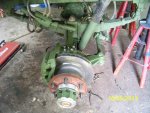mudguppy
New member
- 1,587
- 15
- 0
- Location
- duncan, sc
With regard to the question of whether or not the OE deuce MC can be used to run disc calipers - even if it can and has the capacity and pressure capability, if I was to do it again, I would still swap in a modern two-chamber MC. The added cost is not in the MC, but in the brake booster. However, I personally believe that most people who will be looking at swapping to discs already have or are considering a power steering swap - perfect source for adding a hydro-boost.
So, all in all, I would do the braking mods post or in conjunction with steering improvements and do it the same way. I know I love how my truck steers and love how it stops (thanks again, Steve!).
$0.02
So, all in all, I would do the braking mods post or in conjunction with steering improvements and do it the same way. I know I love how my truck steers and love how it stops (thanks again, Steve!).
$0.02



